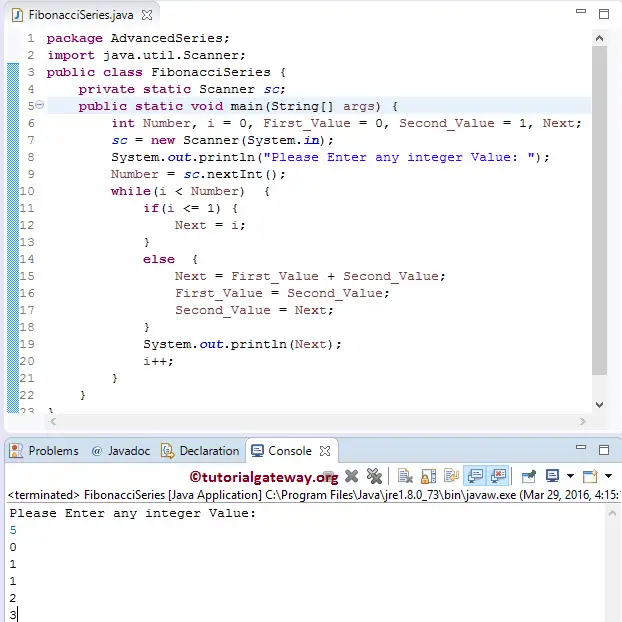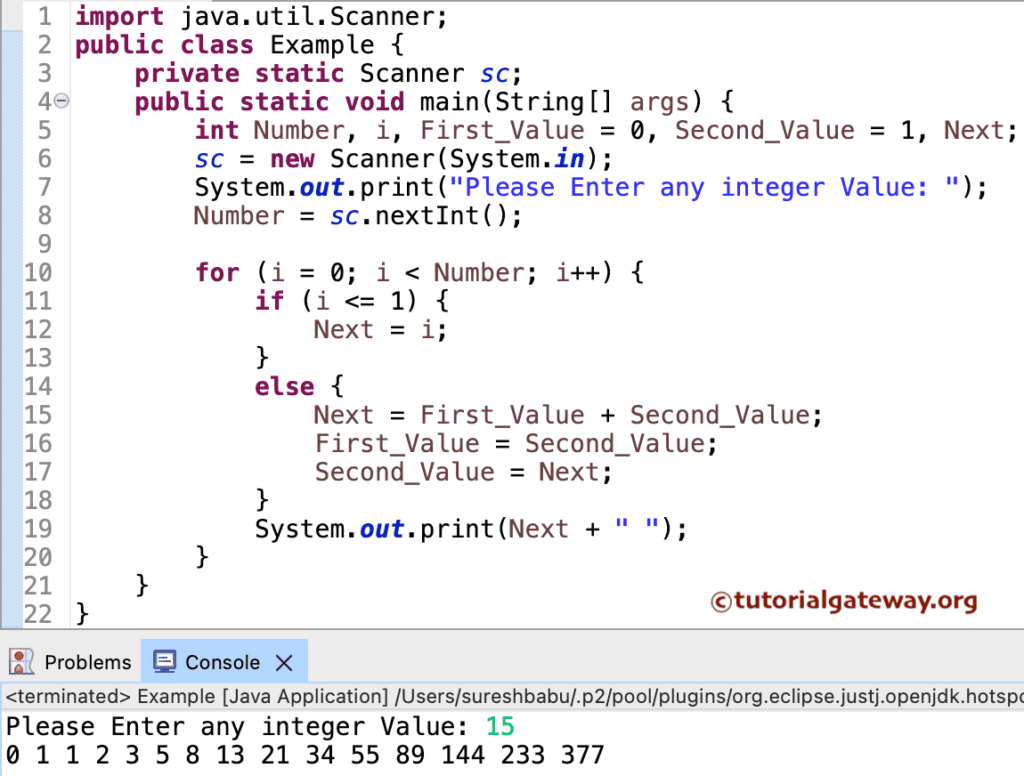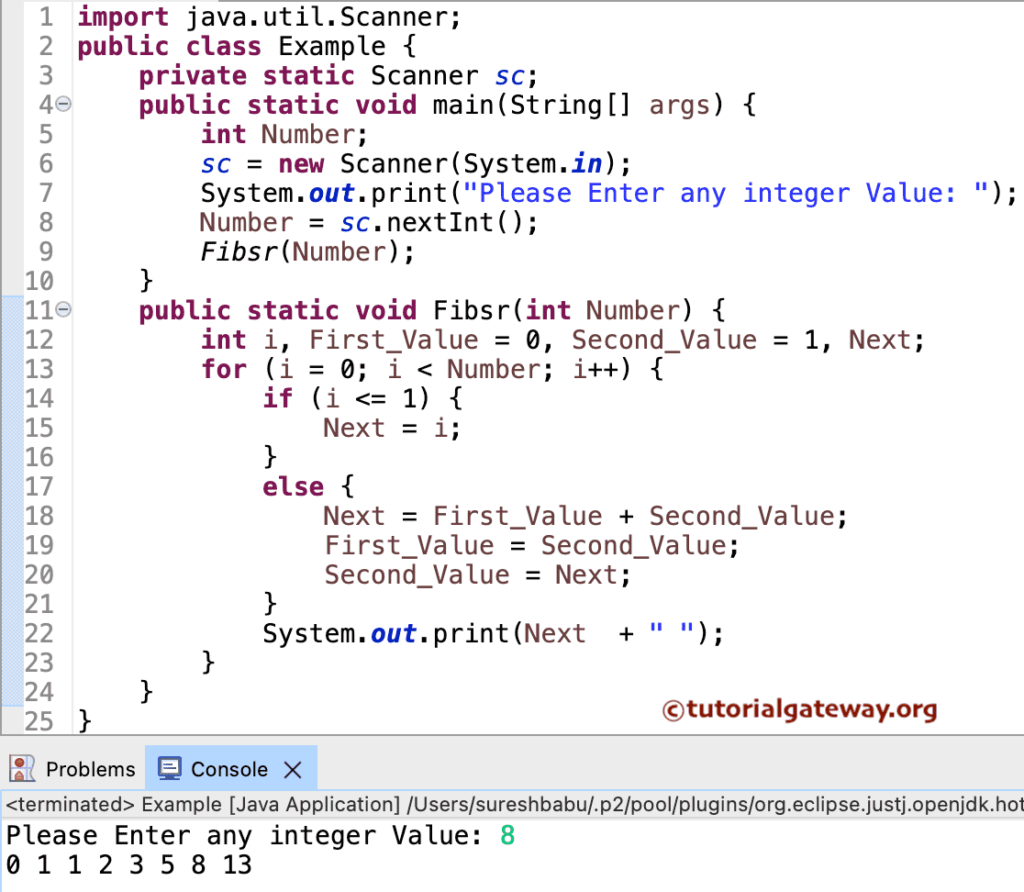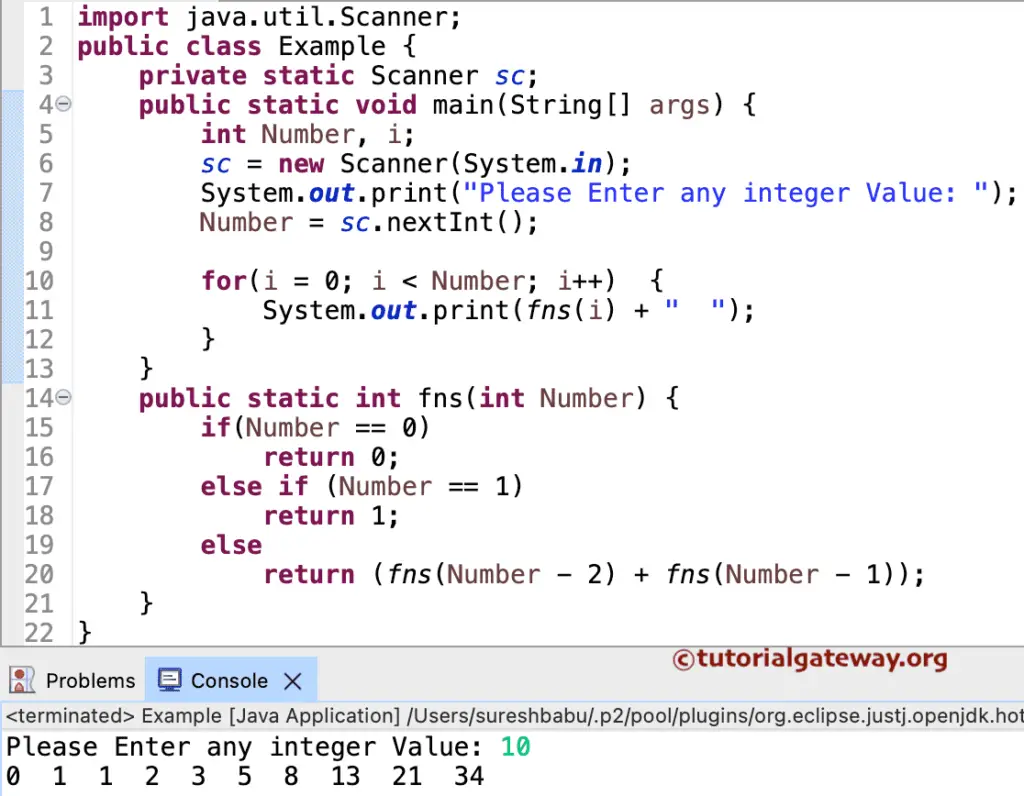Write a Java Program to Print the Fibonacci Series of Numbers using While Loop, For Loop, Functions, and Recursion. The Fibonacci Series are the numbers displayed in the following sequence : 0, 1, 1, 2, 3, 5, 8, 13, 21, 34 …
Java Fibonacci Series Program using While Loop
This program using a while loop allows entering a positive integer. Then, this Java program displays the Fibonacci series of Numbers from 0 to a given number using the While Loop.
package AdvancedSeries;
import java.util.Scanner;
public class FibonacciSeries {
private static Scanner sc;
public static void main(String[] args) {
int Number, i = 0, First_Value = 0, Second_Value = 1, Next;
sc = new Scanner(System.in);
System.out.println("Please Enter any integer Value: ");
Number = sc.nextInt();
while(i < Number) {
if(i <= 1) {
Next = i;
}
else {
Next = First_Value + Second_Value;
First_Value = Second_Value;
Second_Value = Next;
}
System.out.println(Next);
i++;
}
}
}

Let us see the working principle of the while loop in this Java Fibonacci Series program iteration-wise. Number = 5 and as we know i = 0, First_Value = 0, Second_Value = 1
In this Program, the While loop starts from 0 and iterates up to a given value. Within the While loop, we used the If Else statement in this programming.
First Iteration
- While (0 < 5) is TRUE. So, the program will start executing statements inside the while loop.
- The condition if (0 <= 1) is TRUE within the while loop. So, Next = 0, and the compiler will exit from the if statement block.
- Print statement System.out.println(Next) will print the value 0
- Lastly, i incremented to 1. Please refer to the Increment and Decrement Operators article.
Second Iteration
- While (1 < 5) is TRUE.
- if (1 <= 1) is TRUE. So, it prints 1
- i will increment to 1
Java Fibonacci Series program Third Iteration
- While (2 < 5) is TRUE.
- if (2 <= 1) is FALSE. So, the statements inside the else block will start executing.
- Next = First_Value + Second_Value ==> 0 + 1 = 1
- First_Value = Second_Value = 1
- Second_Value = Next = 1
- Next, it prints 1, and i increments by 1.
Fourth Iteration
- While (3 < 5) is TRUE.
- if (3 <= 1) is FALSE.
- Next = 1 + 1 = 2
- First_Value = Second_Value = 1
- Second_Value = Next = 2
- prints 2.
- i will increment to 1.
Fifth Iteration of the Java Fibonacci series program
- While (4 < 5) is TRUE.
- if (4 <= 1) is FALSE.
- Next = 1 + 2 = 3
- First_Value = Second_Value = 2
- Second_Value = Next = 3
- Next, it prints 3 and increments i by 1.
Sixth Iteration: While (5 < 5) is FALSE. So, the program will exit from the while loop. Our final output of the Next values is 0 1 1 2 3
Java Fibonacci Series Program using For Loop
This program uses For Loop to display the Fibonacci series of numbers from 0 to a number. The code below is the same as the above.
import java.util.Scanner;
public class FSUsingFor {
private static Scanner sc;
public static void main(String[] args) {
int Number, i, First_Value = 0, Second_Value = 1, Next;
sc = new Scanner(System.in);
System.out.println("Please Enter any integer Value: ");
Number = sc.nextInt();
for(i = 0; i < Number; i++) {
if(i <= 1) {
Next = i;
}
else {
Next = First_Value + Second_Value;
First_Value = Second_Value;
Second_Value = Next;
}
System.out.println(Next);
}
}
}

Java Program for Fibonacci Series of Numbers using Functions
This example uses functions to display the numbers from 0 to a number.
import java.util.Scanner;
public class FSUsingFunctions {
private static Scanner sc;
public static void main(String[] args) {
int Number;
sc = new Scanner(System.in);
System.out.println("Please Enter any integer Value: ");
Number = sc.nextInt();
Fibsr(Number);
}
public static void Fibsr(int Number) {
int i, First_Value = 0, Second_Value = 1, Next;
for(i = 0; i < Number; i++) {
if(i <= 1) {
Next = i;
}
else {
Next = First_Value + Second_Value;
First_Value = Second_Value;
Second_Value = Next;
}
System.out.println(Next);
}
}
}

In this program, When the compiler reaches the Fibsr(Number) line, it jumps to the below function:
public static void Fibsr(int Number) {
Java Program to Print Fibonacci Series of Numbers using Recursion
This program for the Fibonacci Series displays the numbers from 0 to N using the Recursion and OOPS. In this example, we will first create a class with a method to reverse an integer recursively.
public class CalFib {
public int fns(int Number) {
if(Number == 0)
return 0;
else if (Number == 1)
return 1;
else
return (fns(Number - 2) + fns(Number - 1));
}
}
Within the Main, we will create an instance of the class and call the methods.
import java.util.Scanner;
public class FSUsingRecusrsion {
private static Scanner sc;
public static void main(String[] args) {
int Number, i;
sc = new Scanner(System.in);
System.out.println("Please Enter any integer Value: ");
Number = sc.nextInt();
CalFib fib = new CalFib();
for(i = 0; i < Number; i++) {
System.out.println(fib.fns(i));
}
}
}

In this Java Fibonacci Series program class, we defined a function. It accepts integer values and returns an integer value.
public int fns(int Number) {
Let us see the Else If statement inside the above-specified functions
- if (Number == 0) if it is TRUE, the function returns the value Zero.
- if (Number == 1) – if TRUE, the function will return the value One.
- And if the number is greater than 1, the statements inside the else block are executed.
We called the function recursively within the Else block to display the result.
return (fns(Number - 2)+ fns(Number - 1));
For example, Number = 2
==> (fns(Number – 2) + fns(Number – 1))
==> (fns(2 – 2) + fns(2 – 1)), It means
(fns (0)+ fns(1))
==> return (0 + 1) = return 1.
Main Class Analysis
Within the Program main class, first, we created an instance / created an Object of the Class.
CalFib fib = new CalFib();
Next, we declare a For Loop, and within the for loop, we call the fns(int Number) method. Here, the System.out.println statement will print the output.
for(i = 0; i < Number; i++) {
System.out.println(fib.fns(i));
}
